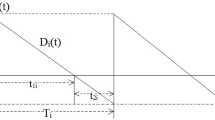Abstract
This paper is concerned with an integrated inventory problem under trade credit where both the demand rate and deteriorating rate are assumed to be uncertain and characterized as fuzzy random variables with known distributions. The objective of this paper is to determine the optimal inventory policy by optimizing simultaneously the replenishment cycle length and trade credit period. At first, three decision criteria are given: (1) expected value criterion, (2) chance-constrained criterion and (3) chance maximization criterion. Then, after building the fuzzy random models based on the above decision criterion, a hybrid intelligent algorithm by integrating fuzzy random simulation and genetic algorithm is employed to deal with these models. At the end, three numerical examples are given to illustrate the benefits of the models and show the effectiveness of the algorithms.

Similar content being viewed by others
References
Banerjee, A. (1986). A joint economic-lot-size model for purchaser and vendor. Decision Science, 17(3), 292–311.
Chang, H. C., Ho, C. H., Ouyang, L. Y., & Su, C. H. (2009). The optimal pricing and ordering policy for an integrated inventory model when trade credit linked to order quantity. Applied Mathematical Modelling, 33(7), 2978–2991.
Charnes, A., & Cooper, W. W. (1959). Chance-constrained programming. Management Science, 6, 73–79.
Chen, L. H., & Kang, F. S. (2010). Integrated inventory models considering the two-level trade credit policy and a price-negotiation scheme. European Journal of Operational Research, 205(1), 47–58.
Cohen, M. A., & Lee, H. L. (1988). Strategic analysis of integrated production distribution systems-models and methods. Operations Research, 36(2), 216–228.
Dutta, P., Chakraborty, D., & Roy, A. R. (2005). A single-period inventory model with fuzzy random variable demand. Mathematical and Computer Modelling, 41(8–9), 915–922.
Goyal, S. K. (1977). An integrated inventory model for a single supplier-single customer problem. International Journal of Production Research, 15(1), 107–111.
Kaplan, R. S. (1970). A dynamic inventory model with stochastic lead times. Management Science, 16(7), 491–507.
Kwakernaak. H. (1978). Fuzzy random variables-I. Definitions and theorems, Information Sciences, 15, 1–29.
Lee, H. M., & Yao, J. S. (1998). Economic production quantity for fuzzy demand quantity, and fuzzy production quantity. European Journal of Operational Research, 109(1), 203–211.
Liu, B. (2002). Random fuzzy dependent-chance programming and its hybrid intelligent algorithm. Information Sciences, 141(3–4), 259–271.
Liu, B. (2009). Theory and practice of uncertain programming (2nd ed.). Berlin: Springer.
Liu, B., & Iwamura, K. (1998a). Chance constrained programming with fuzzy parameters. Fuzzy Sets and Systems, 94, 227–237.
Liu, B., & Iwamura, K. (1998b). A note on chance constrained programming with fuzzy coefficients. Fuzzy Sets and Systems, 100, 229–233.
Liu, Y.-K., & Liu, B. (2003). Fuzzy random variables: A scalar expected value operator. Fuzzy Optimization and Decision Making, 2(2), 143–160.
Maiti, M. K., & Maiti, M. (2007). Two storage inventory model in a mixed environment. Fuzzy Optimization and Decision Making., 6(4), 391–426.
Mandal, S., Maity, A. K., Maity, K., Mondal, S., & Maiti, M. (2011). Multi-item multi-period optimal production problem with variable preparation time in fuzzy stochastic environment. Applied Mathematical Mdelling, 35(9), 4341–4353.
Schmitt, A. J., Snyder, L. V., & Shen, Z.-J. M. (2010). Inventory systems with stochastic demand and supply: Properties and approximations. European Journal of Operational Research, 206(2), 313–328.
Sommer, G. (1981). Fuzzy inventory scheduling. In G. Lasker (Ed.), Applied systems and cybernetics, VI. New York: Acdameic Press.
Van Eijs, M. J. G. (1993). A note on the joint replenishment problem under constant demand. Journal of the Operation Research Society, 44(2), 185–191.
Xu, W. H., Ma, W. M., & Yu, F. K. (2010). An analysis of the co-operative supply chain’s EPQ model under trade credit. Journal of Convergence Information Technology, 5(6), 180–188.
Acknowledgments
The work was partly supported by the National Natural Science Foundation of China (71071113), a Ph.D. Programs Foundation of Ministry of Education of China (20100072110011), a Foundation for the Author of National Excellent Doctoral Dissertation of P.R. China (200782), Shanghai Pujiang Program, and Shanghai Philosophical and Social Science Program (2010BZH003), the Fundamental Research Funds for the Central Universities.
Author information
Authors and Affiliations
Corresponding author
Rights and permissions
About this article
Cite this article
Xu, W. Integrated inventory problem under trade credit in fuzzy random environment. Fuzzy Optim Decis Making 13, 329–344 (2014). https://doi.org/10.1007/s10700-014-9177-1
Received:
Accepted:
Published:
Issue Date:
DOI: https://doi.org/10.1007/s10700-014-9177-1




